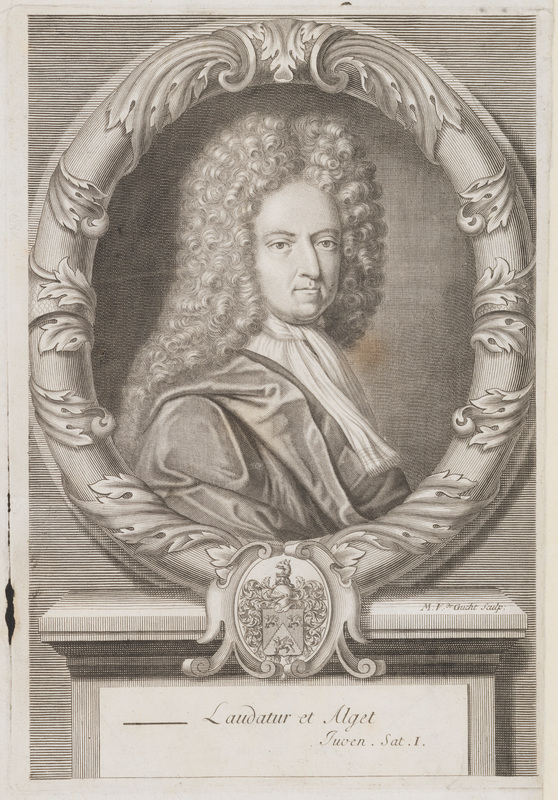Headnote for Daniel Defoe
By
John O'Brien
 Source: Frontispiece portrait of Defoe (National Portrait Gallery, UK)Daniel Defoe (c. 1660-1731) came to writing fiction in late middle age, after decades in which he did a variety of things. He grew up in a Dissenting household in London; his father, James Foe, made and sold candles. (Daniel added the prefix "de" to his name some time in the 1690s, probably to make himself appear more sophisticated). Since his family were not members of the Church of England, Defoe could not go to either Cambridge or Oxford, but he had a good education at a separate school set up for Dissenters, and it seems as though he intended to become a minister. We do not know why that plan changed, but by the mid-1680s at least, Defoe had set out to make his living as a London tradesman. Defoe ran several businesses in his twenties, thirties, and forties: he owned a factory that made roofing tiles, he sold men's undergarments and stockings, he raised civet cats (for the purposes of making perfume), he invested in a scheme to build diving bells to reach sunken treasure. All of these businesses ultimately failed, and Defoe declared bankruptcy more than once in his life. Lawsuits from the period suggest that Defoe was perhaps not always the most scrupulous businessman in history, either.
Source: Frontispiece portrait of Defoe (National Portrait Gallery, UK)Daniel Defoe (c. 1660-1731) came to writing fiction in late middle age, after decades in which he did a variety of things. He grew up in a Dissenting household in London; his father, James Foe, made and sold candles. (Daniel added the prefix "de" to his name some time in the 1690s, probably to make himself appear more sophisticated). Since his family were not members of the Church of England, Defoe could not go to either Cambridge or Oxford, but he had a good education at a separate school set up for Dissenters, and it seems as though he intended to become a minister. We do not know why that plan changed, but by the mid-1680s at least, Defoe had set out to make his living as a London tradesman. Defoe ran several businesses in his twenties, thirties, and forties: he owned a factory that made roofing tiles, he sold men's undergarments and stockings, he raised civet cats (for the purposes of making perfume), he invested in a scheme to build diving bells to reach sunken treasure. All of these businesses ultimately failed, and Defoe declared bankruptcy more than once in his life. Lawsuits from the period suggest that Defoe was perhaps not always the most scrupulous businessman in history, either.
Alongside these business ventures or, to use the lingo of the period, "projects," from his mid-thirties Defoe also pursued a second career, as a writer. In 1697, he wrote An Essay on Projects, a book that outlined various plans for public and private institutions: a school for young women, insurance schemes for widows and sailors, merchant banks. Writing became a "project" like any other, and eventually it was Defoe's primary occupation. He was a prolific writer of poetry, journalism, conduct literature, economic tracts, political essays, and outright propaganda. Many of these works were published anonymously, so there is a lively and ongoing debate among modern scholars as to exactly how much Defoe wrote in the first two decades of the eighteenth century, and precisely which of the many pamphlets that various people have assigned to him over the years were ones that he actually wrote, But any way you count it, his published output was enormous.
In 1719, Defoe published The Life and Strange Surprizing Adventures of Robinson Crusoe, a work that became an instant success and that immediately became a kind of modern myth, one with great staying power in our collective imaginations ever since. Defoe followed that up with a series of extended works of fiction: The Farther Adventures of Robinson Crusoe (1720), Memoirs of a Cavalier (1720),Captain Singleton (1720); Moll Flanders (1722); Colonel Jacque (1722), A Journal of the Plague Year (1722), The Fortunate Mistress (1724). We now think of these books as important contributors to the history of the novel in English, which would go on in the course of the eighteenth century to become an increasingly popular and sophisticated mode of literature. But Defoe never called these works "novels," and it seems to have been important to him that these extended works of prose fiction seemed to be true stories. Each of these works is narrated in the first person by its protagonist, who sets his or her story in a world that is real and recognizable. And each of these books responds to issues and stories that were circulating in the print media of the day. Robinson Crusoe responds in general terms to the interest in colonialization and travel narratives, but also more specifically to the story of Alexander Selkirk, a Scottish sailor who, like Crusoe, was marooned on an island for several years. Selkirk told his story to Richard Steele, who wrote it up in his own journal, The Englishman in 1713. Moll Flanders responds to the intense public in crime and criminals in the 1720s. The Fortunate Mistress is surely a response of sorts to Eliza Haywood's 1723 work Idalia, or, the Unfortunate Mistress. Given all that he did and wrote in his lifetime, Defoe might be surprised to know that he is now remembered primarily as a writer of fiction, but there is no denying the engrossing power of these works.
Image: Daniel Defoe, from the frontispiece to his poem Jure Divino, published in 1706. (National Portrait Gallery, London)